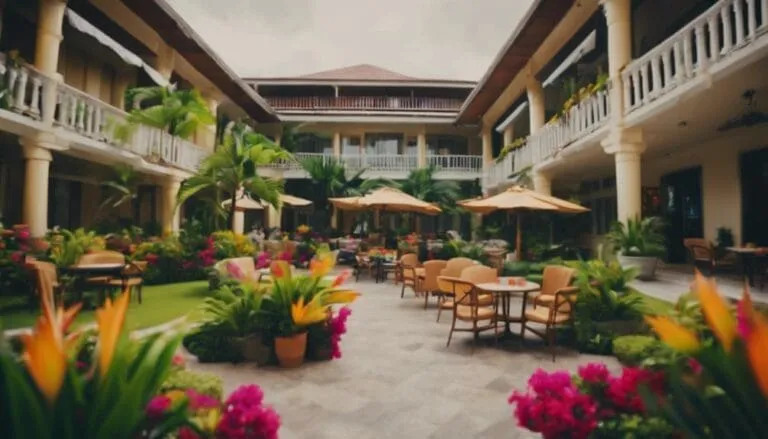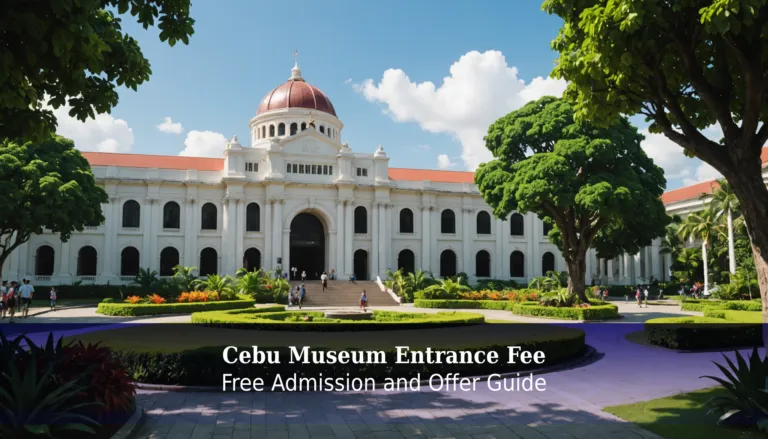Cross of Magellan Significance
When you consider the Cross of Magellan, you're stepping into a narrative that intertwines faith, history, and cultural identity. Planted in Cebu in 1521, this relic isn't just a marker of Christianity's arrival in the Philippines; it stands as a witness to the collision and fusion of indigenous and European worlds. But what does this cross truly represent beyond its historical inception? Understanding its significance will take you beyond mere dates and events, revealing deeper layers of impact on Filipino culture and identity that continue to resonate today.
Key Takeaways
- Symbolizes the introduction of Christianity to the Philippines by Magellan in 1521.
- Represents cultural fusion between indigenous beliefs and European Catholicism.
- Located in Cebu City, a major pilgrimage site and cradle of Christianity in the Philippines.
- Illustrates the historical impact of European colonization and resistance, particularly the Battle of Mactan.
- Recognized as a National Cultural Treasure, embodying the Philippines' complex cultural and religious heritage.
Historical Context
Magellan's arrival in the Philippine archipelago on March 15, 1521, marked a pivotal moment in history, setting the stage for European expansion and colonization in Southeast Asia. His quest to find a westward route to the Spice Islands inadvertently led to significant encounters with local leaders, most importantly Rajah Humabon of Cebu.
On April 21, 1521, Magellan planted a cross in Cebu, which came to be known as Magellan's cross. This act was more than a mere territorial claim; it symbolized the introduction of Christianity to the indigenous population, a profound cultural shift.
However, this cross also became an early symbol of resistance. Following Magellan's death at the hands of Lapu-Lapu in the Battle of Mactan, the cross stood as an emblem of the Philippines' complex relationship with colonization.
Understanding the historical context of Magellan's cross helps you grasp the broader narrative of resistance and resilience that defines Filipino identity. This moment foreshadowed a long history of defiance against Spanish rule, shaping the cultural and historical landscape of the Philippines.
Magellan's cross in Cebu isn't just a relic; it represents both the imposition of foreign power and the enduring spirit of freedom.
Symbol of Christianity

The cross planted by Ferdinand Magellan on April 21, 1521, stands as a profound symbol of Christianity's introduction to the Philippines. This act marked the birth of Catholicism in the archipelago, fundamentally altering its religious landscape.
Encased in a wooden cross made of tindalo, the original cross is safeguarded within the Basilica del Santo Niño in Cebu City. This encasement underscores its significance as a religious artifact, preserving it from the ravages of time.
Cebu City, often regarded as the cradle of Christianity in the Philippines, attracts thousands of visitors to this sacred site. Pilgrims light candles and offer prayers, reaffirming the cross's role as a beacon of faith in a largely Christian nation. Cebu City also boasts a fascinating blend of old traditions and modern living, making it a destination that appeals to a wide range of travelers. While exploring the spiritual sites, visitors can also indulge in the city’s vibrant culinary scene, which includes a growing number of vegan eateries in Cebu City catering to more health-conscious and sustainability-focused diners. This fusion of faith, culture, and cuisine underscores Cebu’s dynamic identity and its ability to warmly welcome people from all walks of life.
The historical clash between indigenous beliefs and European-introduced Christianity is evident here, reflecting the broader narrative of colonization and cultural transformation.
The cross's enduring presence in Cebu is a witness to its impact. It serves as a tangible link to the past and a symbol of the enduring faith of millions.
Impact on Culture

When you examine the impact of Magellan's Cross on Filipino culture, you'll see its role in blending indigenous beliefs with Catholicism, creating a unique religious identity.
This fusion has shaped the country's cultural heritage and sparked debates about colonialism's effects on local traditions.
As a symbol of religious influence, the cross underscores Catholicism's lasting presence in the Philippines, evidenced by its status as a major pilgrimage site.
Religious Influence
Amidst the historical backdrop of the 16th century, the introduction of Christianity to the Philippines via Magellan's Cross considerably altered the region's cultural and religious landscape. The Christian cross brought by Magellan's wasn't just a religious symbol; it marked the beginning of a significant transformation.
When Rajah Humabon and Queen Juana were baptized, it wasn't merely a personal conversion but a pivotal moment that laid the foundation for Catholicism's enduring presence in the Philippines. This cross not only represents the first successful conversion of indigenous leaders but also the clash between ancient beliefs and the new, foreign religion introduced by European colonizers.
As you explore the cultural landmark today, Magellan's Cross stands as a symbol of this historical turning point. The mural within the pavilion, depicting the baptism of Rajah Humabon, underscores the profound religious shift that has shaped Filipino identity and spiritual life.
Over centuries, the site has evolved into a pilgrimage destination, reflecting Catholicism's deep-rooted influence. The cross is more than a relic; it's a symbol of the dynamic interplay between imposed beliefs and native traditions, a constant reminder of the complex history that continues to shape contemporary Filipino culture.
Cultural Fusion
Magellan's Cross stands as a symbol of the profound cultural fusion that reshaped the Philippines. This emblem, marking the arrival of Christianity, represents the merging of indigenous beliefs with European religious practices. When you look at the cross, you're seeing the confluence of two worlds. The introduction of Christianity via Magellan's Cross laid the groundwork for Catholicism to become an integral part of Filipino identity, influencing everything from daily life to major cultural practices.
Festivals like the Sinulog exemplify this cultural fusion. Celebrated in Cebu, Sinulog integrates Catholic devotion with indigenous rituals, vividly showcasing the blend of traditions. This festival is a living proof of how Magellan's Cross sparked a dynamic interaction between local customs and foreign religion, creating a unique cultural tapestry.
The ongoing reverence for Magellan's Cross highlights the enduring impact of this historical moment. It serves as a focal point for discussions on how colonial history influenced modern Filipino culture.
While it's a symbol of colonial imposition, it also stands for cultural adaptation and resilience. By understanding Magellan's Cross, you gain insight into the complex layers of cultural fusion that define the Philippines today.
Colonial Legacy
The arrival of Christianity through Magellan's Cross profoundly altered the cultural landscape of the Philippines, embedding a colonial legacy that continues to shape Filipino identity. The cross planted by Magellan symbolizes the introduction of Christianity, marking a dramatic shift in the spiritual and cultural narrative of the islands.
This event didn't just change religious practices; it intertwined indigenous beliefs with imported doctrines, forging a unique cultural heritage.
The colonial legacy of the cross is multifaceted:
- Religious Transformation: Catholicism became the dominant faith, influencing every aspect of Filipino life, from daily rituals to community structures.
- Cultural Fusion: Indigenous traditions blended with Christian customs, creating a hybrid culture that reflects the complex history of colonization.
- Historical Precedent: The baptism of Rajah Humabon and Queen Juana set the stage for widespread conversion, impacting the sociopolitical landscape.
- Preservation and Debate: As a National Cultural Treasure, Magellan's Cross sparks ongoing discussions about colonialism's enduring effects and the importance of preserving historical artifacts.
Understanding this colonial legacy helps you appreciate the depth of the Philippines' cultural transformation. The cross planted by Magellan is more than a historical artifact; it's a symbol of resilience and cultural evolution amidst centuries of foreign influence.
Magellan's Voyage

When considering Magellan's voyage, you should recognize its groundbreaking confirmation of Earth's roundness and its substantial contributions to global geography.
The expedition's encounters, particularly the baptism of the first Christian Filipinos, also marked significant cultural and religious shifts.
Furthermore, Magellan's death in the Battle of Mactan underscores the resistance to European colonization, signaling the complex legacies of these early interactions.
Circumnavigation and Global Impact
Starting on a journey that would forever change the course of history, Ferdinand Magellan's voyage in 1519 stands as a monumental achievement in human exploration.
By successfully completing the first circumnavigation of the globe, Magellan's expedition confirmed the Earth's roundness and reshaped European understanding of geography. This journey not only demonstrated the vastness of the Pacific Ocean but also underscored the potential for new trade routes and economic opportunities.
Magellan's fleet discovered numerous islands, including those of the Philippine archipelago. The encounter at Cebu marked the first recorded contact between Europeans and Filipinos, greatly impacting future European colonization efforts in Asia.
The information gathered from this voyage provided essential insights into previously unknown regions, spurring a wave of maritime exploration among European powers.
Here's how Magellan's circumnavigation influenced global dynamics:
- Confirmed Earth's Roundness: Solidified the scientific understanding of our planet's shape.
- Expanded Trade Routes: Opened new avenues for European-Asian trade.
- Spurred Further Exploration: Encouraged other nations to initiate their own voyages.
- Geopolitical Shifts: Altered colonial ambitions and power structures globally.
Magellan's voyage, with its groundbreaking achievements, ignited a spirit of exploration and freedom that resonated through centuries.
Cultural Encounters and Legacies
Magellan's circumnavigation not only reshaped global trade and geopolitical landscapes but also brought about profound cultural encounters that left lasting legacies. When Magellan's expedition reached the Philippine archipelago in 1521, it marked the first European contact with this region. By planting Magellan's Cross in Cebu on April 21, Magellan introduced Christianity, initiating significant cultural and religious transformations.
This encounter wasn't merely an exchange of beliefs; it also led to resistance. Indigenous leader Lapu-Lapu's stand against Magellan's forces symbolizes early Philippine resistance to European colonization. The legacy of this encounter profoundly impacted the cultural identity of the Philippines, blending indigenous and European elements.
To understand these encounters and their legacies, consider the following table:
| Event | Impact | Legacy |
|---|---|---|
| Arrival in Philippines | First European contact | Cultural exchange |
| Planting of the Cross | Introduction of Christianity | Religious transformation |
| Encounter with Lapu-Lapu | First resistance to colonization | Symbol of native resistance |
| Route confirmation | Global geographic awareness | Influenced future explorations |
| Cultural fusion | Blending of cultures | Shaped national identity |
Cultural Heritage

The cultural heritage embodied by Magellan's Cross is a profound representation of the Philippines' rich historical tapestry. This iconic landmark isn't just a symbol; it encapsulates pivotal moments that shaped the nation's identity.
Magellan's Cross signifies the introduction of Christianity in 1521, when Ferdinand Magellan planted the wooden cross, marking the conversion of local leaders Rajah Humabon and Queen Juana. This act bridged indigenous and foreign cultures, embedding a new religious dimension into Filipino life.
Located at the Basilica Minore Del Santo Niño in Cebu, the cross is housed in a pavilion declared a National Cultural Treasure by the National Museum of the Philippines in 2021. This recognition underscores its role in preserving the nation's cultural heritage.
The mural depicting Rajah Humabon's baptism further enriches this narrative, illustrating the initial spread of Catholicism.
Consider these key aspects:
- Historical Significance: Magellan's Cross represents the dawn of Christianity in the Philippines.
- Cultural Fusion: It marks the blending of local and foreign traditions.
- National Recognition: The cross is a recognized National Cultural Treasure.
- Educational Value: The mural serves as a visual history lesson on the Philippines' colonial and religious past.
Understanding Magellan's Cross deepens your appreciation of the intricate cultural heritage of the Philippines.
Visitor Experience

Stepping into the pavilion housing Magellan's Cross, you'll immediately feel a serene ambiance that invites contemplation and spiritual reflection.
This environment is perfect for those seeking a moment of peace or a deeper spiritual journey. The serene setting enhances your visit, providing a space ideal for prayer and personal reflection.
Outside the chapel, local vendors offer candles and prayer services, allowing you to engage in traditional practices that connect you more deeply with the site's spiritual heritage.
This cultural immersion isn't only enriching but also supports the local community.
Informational displays around Magellan's Cross provide context about its historical and religious significance.
By learning about the cross's role in the spread of Christianity and its importance during the Sinulog Festival honoring Santo Niño, you gain a greater appreciation for Cebu's rich cultural tapestry.
Accessing Magellan's Cross is convenient, located centrally in downtown Cebu.
With no entrance fee, the site is welcoming to everyone, including both locals and tourists.
This accessibility guarantees that all visitors can experience the historical and spiritual essence of Magellan's Cross without barriers, making it a truly democratic landmark.
Frequently Asked Questions
Why Should We Visit Magellan's Cross?
You should visit Magellan's Cross to explore its historical context, appreciate its cultural heritage, and investigate local legends. It's a unique opportunity to connect with the complex history and identity of the Philippines.
Is the Magellan's Cross Real?
You might question the historical authenticity of Magellan's Cross, but its cultural impact and significance as a tourist attraction remain undeniable. The encased cross symbolizes the fusion of Filipino heritage, making it a must-visit site.
What Is the Painting in Magellan's Cross?
The painting in Magellan's Cross provides an artistic interpretation of the baptism of Rajah Humabon, illustrating its profound cultural impact. It offers historical context, showing the fusion of indigenous beliefs with Christianity during Spanish colonization.
What Is the Significance of Magellan Shrine?
You'll find the Magellan Shrine significant due to its rich historical context, cultural heritage, and religious symbolism. It marks the introduction of Christianity in the Philippines, making it a pivotal site for both history buffs and spiritual seekers.
Conclusion
In visiting the Cross of Magellan, you'll witness the profound impact of Christianity's introduction to the Philippines. This historical symbol encapsulates the convergence of indigenous and European influences, highlighting both colonial imposition and cultural resilience. By understanding its historical context and cultural significance, you'll appreciate how it has shaped Filipino identity. This site doesn't just mark a historical event; it's a living proof of the enduring fusion of diverse traditions and beliefs.







